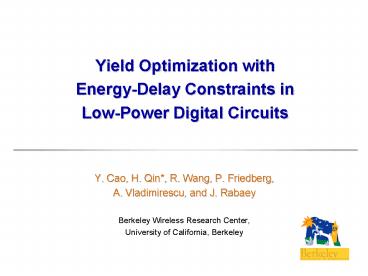Yield Optimization with EnergyDelay Constraints in LowPower Digital Circuits PowerPoint PPT Presentation
1 / 21
Title: Yield Optimization with EnergyDelay Constraints in LowPower Digital Circuits
1
Yield Optimization with Energy-Delay Constraints
in Low-Power Digital Circuits
- Y. Cao, H. Qin, R. Wang, P. Friedberg,
- A. Vladimirescu, and J. Rabaey
- Berkeley Wireless Research Center,
- University of California, Berkeley
2
Outline
- Motivation
- Impact of parametric variations on yield
- Yield definition and statistical models
- Tradeoffs of Yield, Power, and Timing
- Vdd and Vth tuning
- Transistor sizing
- Yield-Aware Circuit Optimization
- Conclusion
3
Parametric Variations in IC Design
(Figure courtesy of S. Nassif, IBM)
- Process Variations
- Lithography Lgate (15)
- Doping Vth (30), Leff (15)
- Gate oxide Tox (4)
- Metal definition line size (20)
- Circuit Operation
- Power supply Vdd (10)
- Crosstalk noise ?Td / Td (gt50)
- Temperature fluctuation
4
Impact of Variations
- Circuit timing
- Timing specifications have to be pushed further
and further away from mean value. - Yield loss occurs otherwise.
- Power consumption
- Extra leakage at standby mode.
- Design methodology
- Traditional worst-case bounded design approach is
wasteful on resources. - Redundancies in logic and circuits are necessary
to ensure correct functionality but they also
come at expenses. - Besides speed and power, yield becomes another
important parameter in circuit design. - Effective yield-aware design optimization methods
are needed.
5
Defining Yield Metric For Optimization Analysis
- Yield
- Percentage of registered circuit stages whose
delays fall within the performance boundary. - Consistent with normalized variability, which is
3?/?. - Reflects design expectation during optimization.
Performance boundary mean delay (110)
6
Circuit Performance Models
- Nominal models Alpha-power law based
- Delay (glogical effort, helectrical effort,
pparasitic delay) - Active energy
- Standby energy
7
Circuit Performance Models
- Statistical model Log-normal
- Digital circuits statistical behavior deviates
from normal distribution especially under low Vdd
and high Vth. - Delays above mean value
- spreads wider than those
- below mean value.
- It is due to the non-linear
- delay function
Multiplication central theorem Product of
Gaussian variables approximates log-normal
distribution.
8
Log-Normal vs. Normal
High Vth
Difference in mean value
Medium Vth
Low Vth
0
500
1000
1500
2000
Delay (ps)
- Log-normal behavior is more pronounced under
low-Vdd and high-Vth operation. - Applying normal delay model for circuits at low
(Vdd/Vth) ratio results in error in yield
analysis.
9
Outline
- Motivation
- Impact of parametric variations
- Yield definition and statistical models
- Tradeoffs of Yield, Power, and Timing
- Vdd and Vth tuning
- Transistor sizing
- Yield-Aware Circuit Optimization
- Conclusion
10
Trade off Yield, Timing, and Power
- Speed and power tradeoff optimization has been
well studied. - Now we are up to the stage where
- Traditional worst-case design methodology
- Faces intolerable margin in the presence of
increasing variations. - Sacrifices both timing and power.
- Yield concerns limit power reduction.
- Wide delay distribution under low Vdd and high
Vth, which are key low power design features. - Yield-aware design methodology is important
across all levels of VLSI design!
11
Simulation Setup
- Monte-Carlo SPICE simulations of canonical
circuits inverter chain, NAND chain, and a 4-bit
adder.
12
Technology Specifications
- A 130nm industrial technology
- First-order variation sources Leff, Vth, and
Vdd. - Constant 3?/? is assigned to Vdd (Vth) in Vdd
(Vth) tuning. - ? of Vth is correlated to transistor size
13
Vdd and Vth Tuning
Switching Energy
Delay
Total Leakage Energy
Yield
14
Favorable Yield-Power Tradeoffs
10
10
Orders of magnitude
50
- Yield-power tradeoff is favorable for low-power
designs. - High-level yield boosting techniques can
compensate low-level variations, achieving better
power efficiency.
15
Circuit Sizing Starting with Inverter Chain
- When only considering speed and power trade off
- Tapering factor u is tuned for the optimization
- When yield concern is included
- ?Vth(W, L), the dependence of Vth variation on
transistor size, is important for yield
estimation. - Due to ?Vth(W, L), smaller sized inverter (i.e.,
larger u) has more severe yield loss (about 5 in
this case), especially under low Vdd condition.
16
Other Design Factors
- This observation relies on the assumption of
strong correlations among stages. - Variability with weak and general assumption of
correlations is another on-going work in the
group.
- Yield of digital logic circuits is relatively
insensitive to circuit topology (inverter or
adder) and logic style (static CMOS or PTL).
17
Outline
- Motivation
- Impact of parametric variations
- Yield definition and statistical models
- Tradeoffs of Yield, Power, and Timing
- Vdd and Vth tuning
- Transistor sizing
- Yield-Aware Circuit Optimization
- Conclusion
18
Yield Sensitivity
- Yield is most sensitive to the ratio of Vdd/Vth.
- Yield increases with larger Vdd, Vdd/Vth, and W.
19
A Design Example
130nm Inverter Chain
- With the same power-timing constraints, yield can
be improved by increasing Vdd/Vth, with a reduced
Vdd and larger W.
20
On a System Level Yield-Aware Design Approach
- Bottom-up investigation to bring yield concerns
across all levels - Targeting top-down yield-aware design methodology
21
Conclusion
- Circuit yield degrades with power reduction. Thus
yield is an important concern in low-power
designs. - Yield-power tradeoffs are favorable at
circuit-level. - Under the same power and timing constraints,
yield can be enhanced by optimizing Vdd, Vth, and
sizing together. - Yield-aware design methodology is need for future
robust low-power VLSI designs.

